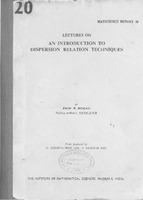- DSpace Home
- →
- MATSCIENCE Reports
- →
- MATSCIENCE Reports
- →
- View Item
JavaScript is disabled for your browser. Some features of this site may not work without it.
| dc.contributor.author | Roman, P. | |
| dc.date.accessioned | 2010-04-09T05:11:33Z | |
| dc.date.available | 2010-04-09T05:11:33Z | |
| dc.date.issued | 2010-04-09T05:11:33Z | |
| dc.date.submitted | 1963 | |
| dc.identifier.uri | https://dspace.imsc.res.in/xmlui/handle/123456789/174 | |
| dc.description.abstract | The idea behind the dispersion relation is as follows: A Physically significant function such as the scattering amplitude is considered, which is in general a function of the real variable k(momentum) and 'theta' (the scattering angle). The first step consists in analytically continuing the function to complex values of its argument. Then it is proceeded to determine its analytic behaviour from the general structure of the underlying theory and the singularities are given a physical interpretation. Cauchy's theorem is invoked to express these analytic properties in a compact form. The resulting mathematical expression is dispersion relation. | en_US |
| dc.description.tableofcontents | I. Introduction 1; II. Mathematical Techniques 7; III. Dispersion Relation for potential scattering 13; IV. The Mandelstam Representation for potential scattering 34; V. Dispersion Relation for Partial Wave Amplitudes 51; VI. The Regge Poles in Potential Scattering 69; VII. Causality and Dispersion Relations 81; VIII. The S-Matrix 104; IX. The S-Matrix in the Angular Momentum Representation 124; X. The S-Matrix in the framework of second quantization 150. | en_US |
| dc.subject | Dispersion Relation | en_US |
| dc.subject | Matscience Report 20 | en_US |
| dc.title | Lectures on 'An Introduction to dispersion relation techniques' [MatSciRep:20] | en_US |
| dc.type.institution | Institute of Mathematical Sciences | en_US |
| dc.description.pages | 179p. | en_US |
| dc.type.mainsub | Mathematics | en_US |
